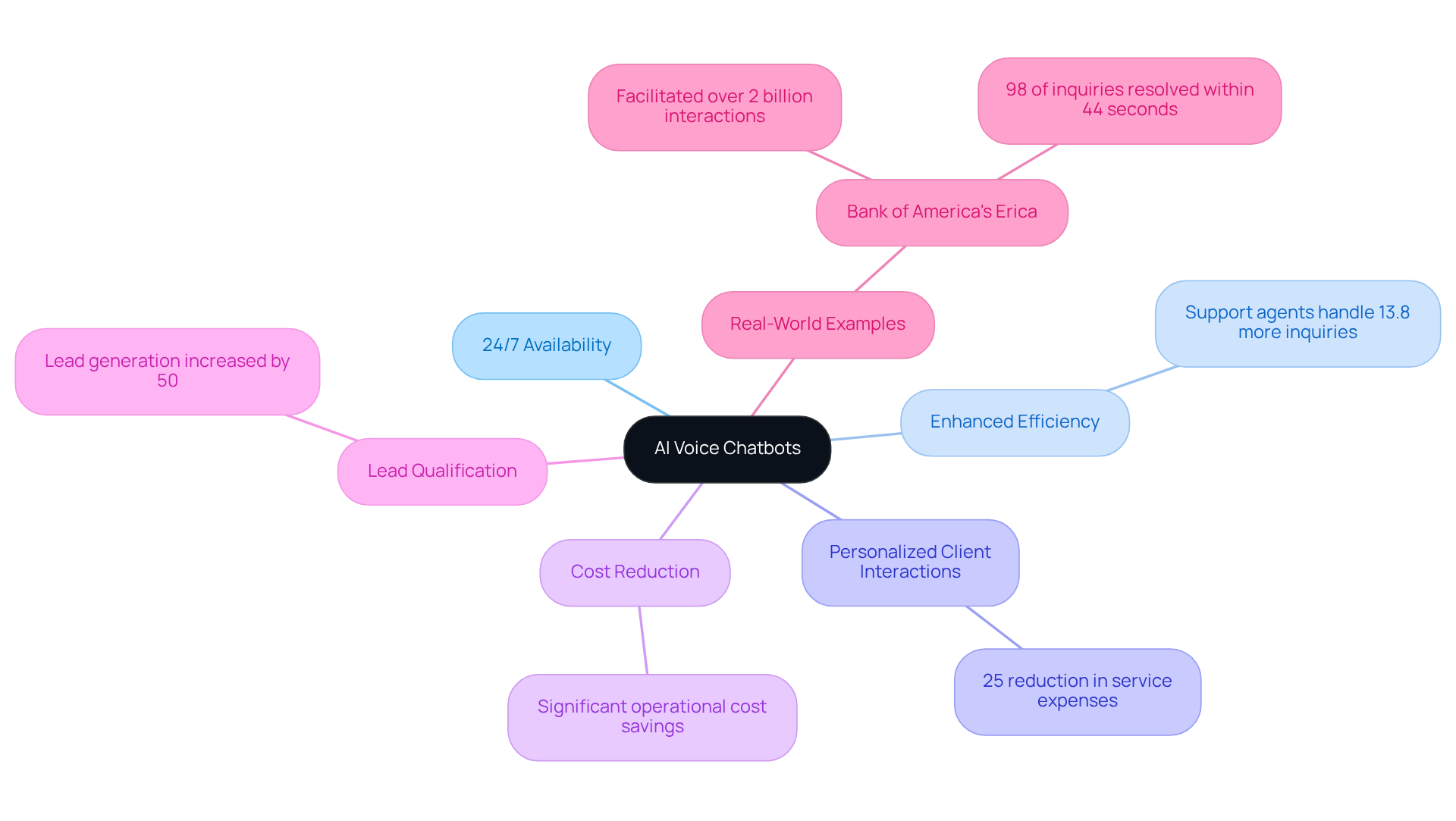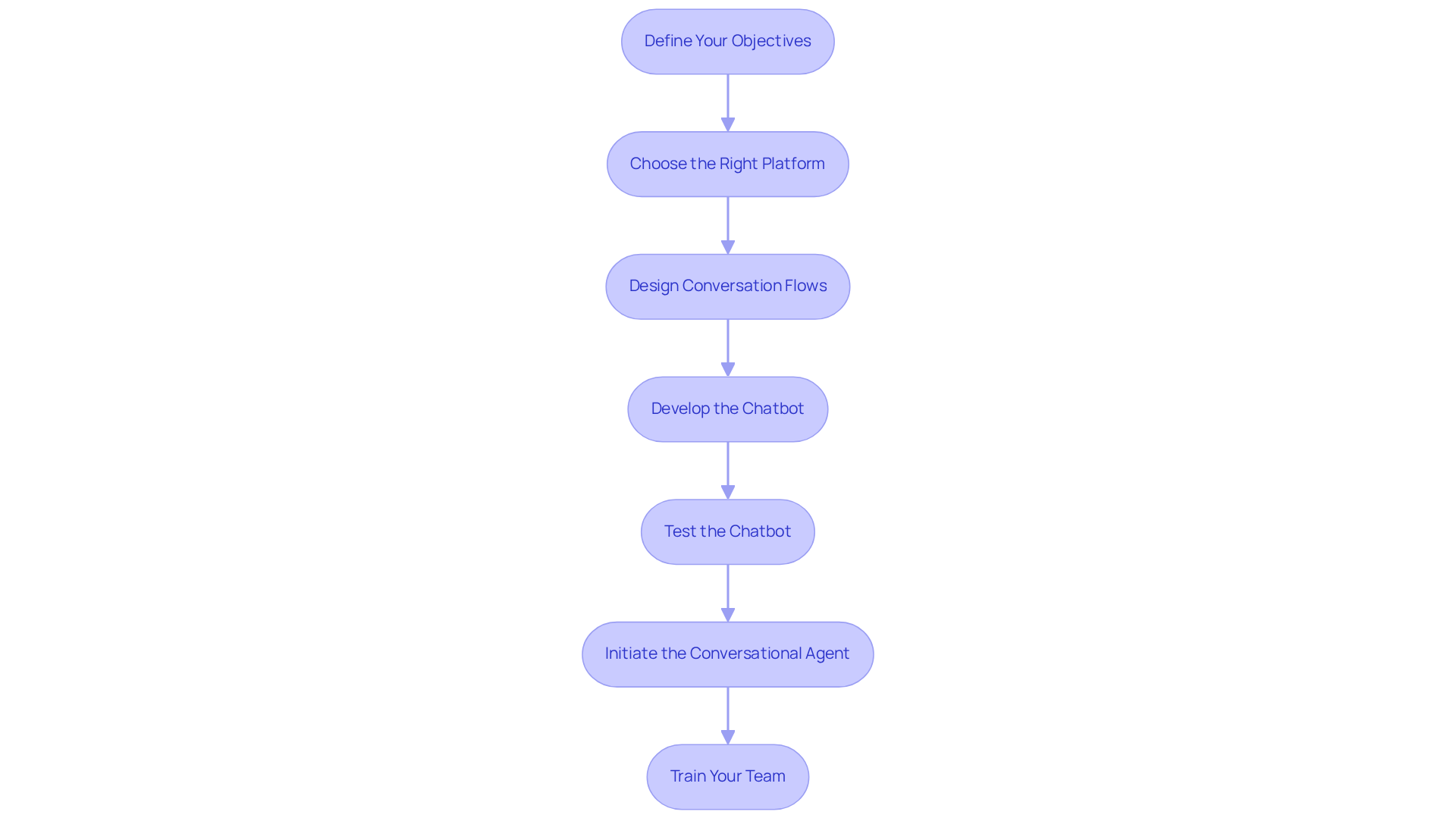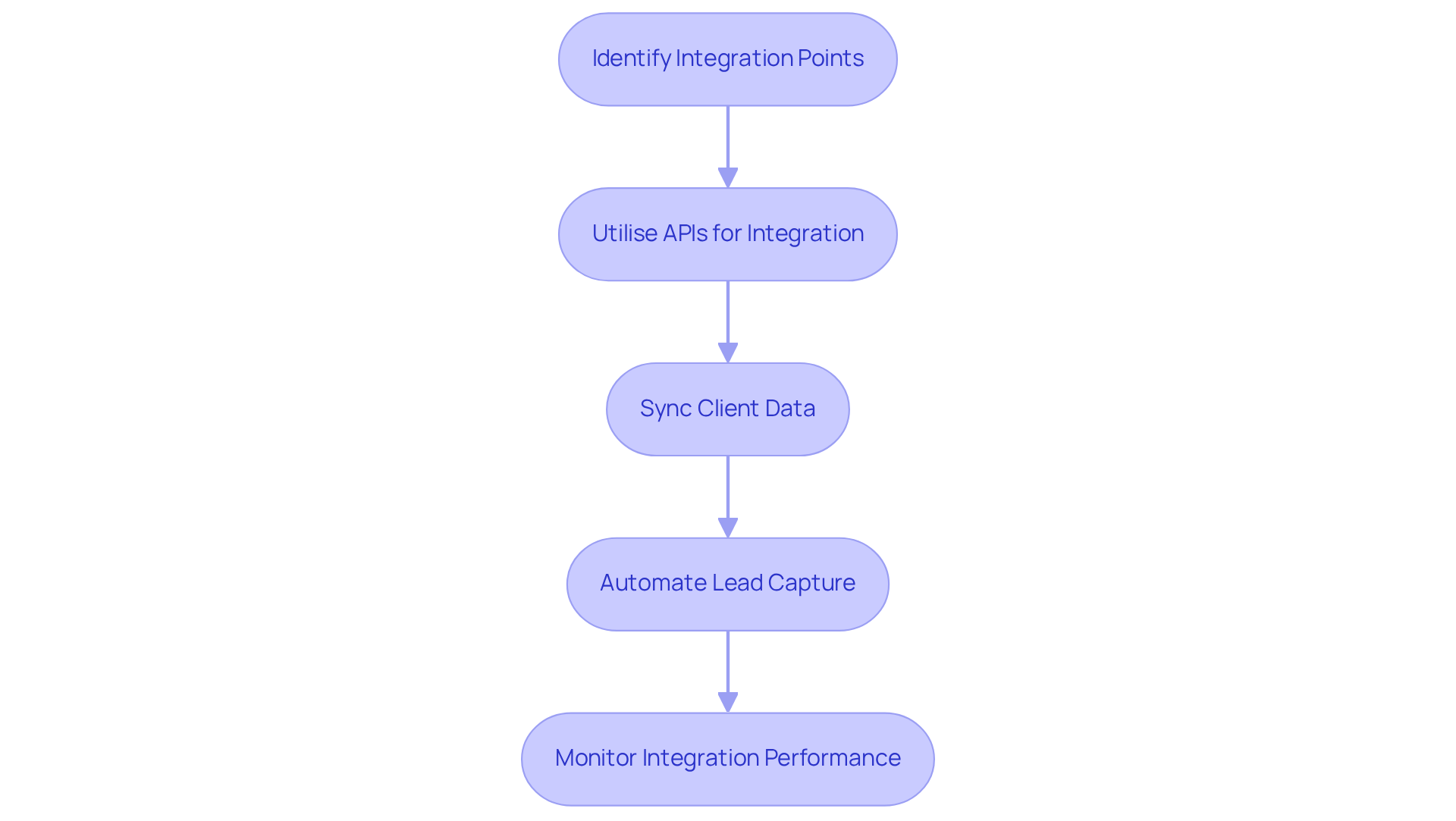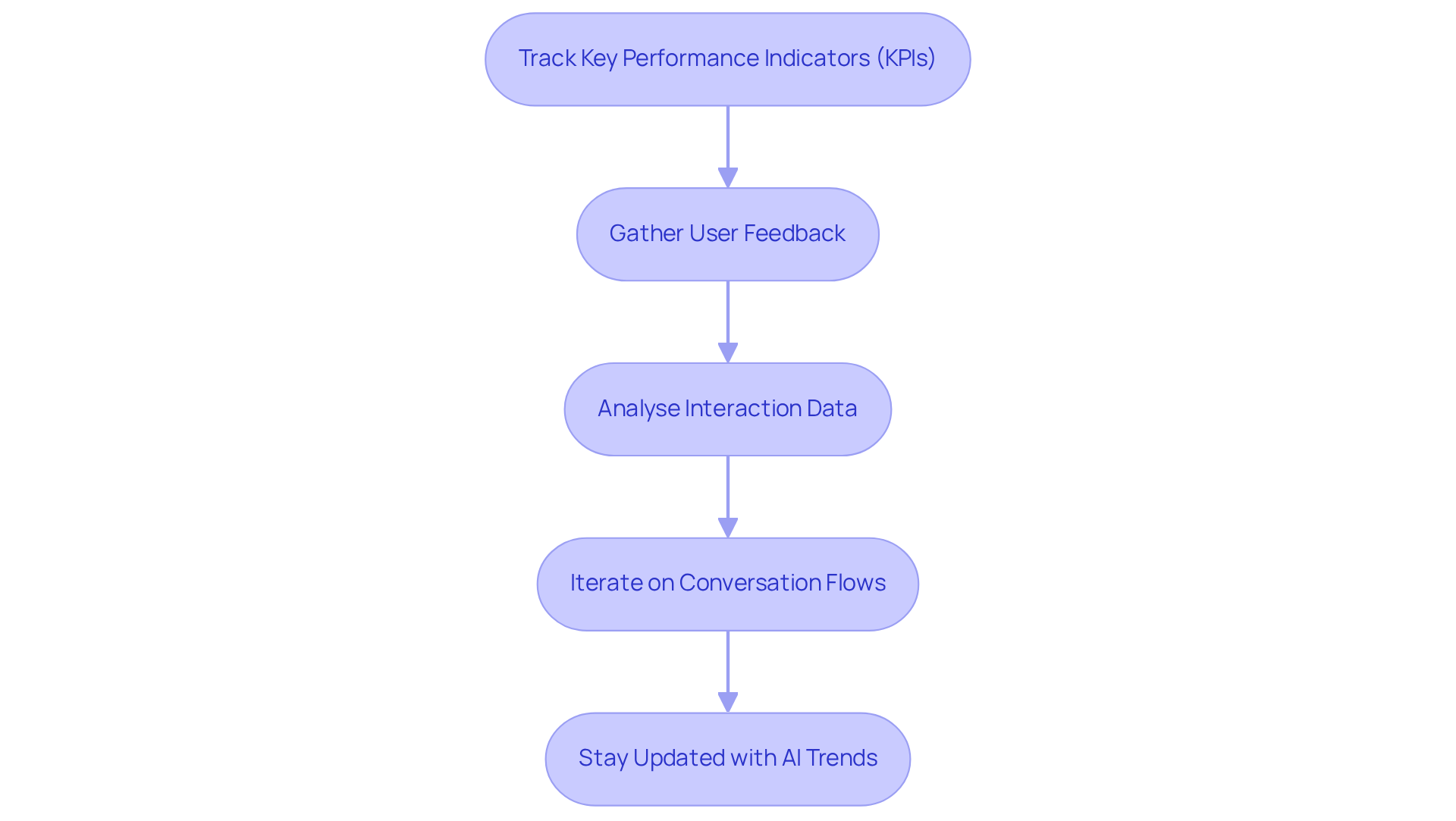
Implement Your AI Voice Chatbot for Sales Success
GeneralOverview
AI voice chatbots present a transformative opportunity for enhancing sales success. Their 24/7 availability, ability to automate lead qualification, and capacity to personalise client interactions collectively lead to improved efficiency and heightened customer satisfaction.
These advantages are not merely theoretical; they are supported by compelling evidence. For instance, the operational cost reductions and increased transaction opportunities showcased by Bank of America’s virtual assistant illustrate the real-world effectiveness of these technologies, which have successfully managed billions of inquiries.
Embrace the future of sales with AI voice chatbots, and unlock the potential for greater success today.
Introduction
AI voice chatbots are revolutionising customer interaction, offering businesses an innovative avenue to engage clients and streamline sales processes. By leveraging advanced technologies such as Natural Language Processing, these intelligent assistants enhance efficiency and deliver personalised experiences that can significantly elevate conversion rates.
As more companies acknowledge the potential of AI-driven solutions, a pivotal question emerges: how can organisations effectively implement and integrate these chatbots to maximise their sales success?
This article explores essential steps and strategies for harnessing the power of AI voice chatbots, paving the way for improved client interactions and substantial revenue growth.
Understand AI Voice Chatbots and Their Benefits
AI voice chatbots represent a cutting-edge solution, employing artificial intelligence to engage in audio-based conversations with users. By harnessing Natural Language Processing (NLP), they understand and respond to client inquiries in real-time, revolutionising customer interaction. The advantages of integrating AI voice chatbots in sales are substantial:
- 24/7 Availability: Unlike human agents, chatbots operate around the clock, ensuring that customer inquiries are addressed promptly, regardless of the time.
- Enhanced Efficiency: Automating routine inquiries and tasks allows sales teams to focus on more complex interactions, resulting in heightened productivity. Notably, statistics indicate that support agents utilising AI tools can handle 13.8% more inquiries per hour, leading to increased transaction opportunities and greater revenue potential.
- Personalised Client Interactions: An AI voice chatbot analyses client data to deliver tailored responses, enriching the client experience and boosting conversion rates. Companies that have adopted AI-powered customer support solutions report a remarkable 25% reduction in service expenses while simultaneously enhancing customer satisfaction, ultimately leading to increased profitability.
- Cost Reduction: By automating transaction processes, organisations can significantly reduce operational costs associated with hiring and training personnel, allowing for more efficient resource allocation.
- Lead Qualification: Chatbots excel at qualifying leads by asking pertinent questions and gathering essential information before transferring them to human agents. This capability can elevate lead generation by as much as 50%, thereby strengthening the sales pipeline.
Real-world examples underscore the effectiveness of AI chatbots in enhancing client interactions. For instance, Bank of America’s virtual assistant, Erica, has facilitated over 2 billion interactions, addressing 98% of inquiries within 44 seconds. This efficiency has substantially reduced call centre load and improved client retention rates.
Industry leaders acknowledge the transformative potential of AI voice chatbots. With 80% of companies planning to implement AI-driven chatbots for client support by 2025, compared to just 40% currently utilising them, the momentum toward adopting these technologies is unmistakable. As organisations increasingly embrace AI, they can expect improved client interaction and operational efficiency, positioning themselves for success in a competitive landscape.

Step-by-Step Guide to Implementing Your AI Voice Chatbot
To successfully implement your AI voice chatbot, follow these essential steps:
-
Define Your Objectives: Clearly outline your goals for the automated assistant, such as enhancing lead generation, improving customer service, or streamlining sales processes. This foundational step ensures that the virtual assistant aligns with your business needs. Agentics’ solutions are designed to meet these objectives effectively, providing tailored features that enhance user engagement.
-
Choose the Right Platform: Select a conversational agent development platform that meets your requirements. Evaluate options based on user-friendliness, integration capabilities with existing systems, and the level of customer support provided. Agentics offers robust integration options that can seamlessly connect with your current systems, ensuring a smooth transition.
-
Design Conversation Flows: Create detailed conversation maps that outline how interactions will unfold. Develop scripts for frequent questions and ensure the automated assistant is prepared to manage a range of situations, thereby improving user experience. With Agentics, you can leverage advanced AI capabilities to design dynamic conversation flows that adapt to user needs.
-
Develop the Chatbot: Utilise your chosen platform to build the chatbot, incorporating advanced speech recognition features and ensuring it can comprehend natural language effectively. This will enable smoother interactions with users and enhance client satisfaction. Agentics’ voice AI technology is specifically engineered to enhance comprehension and responsiveness.
-
Test the Chatbot: Conduct comprehensive testing to identify and resolve any issues. Simulate various client interactions to ensure the automated response system reacts precisely and efficiently, which is vital for sustaining client satisfaction. Ongoing training and performance evaluation are crucial to adjust to changing consumer expectations. Agentics provides tools for ongoing performance analysis to ensure optimal functionality.
-
Initiate the Conversational Agent: After extensive testing, implement the conversational agent across your marketing avenues, such as your website or support line. This step marks the transition from development to real-world application. For instance, a recent case study showed that a client using Agentics’ AI assistant achieved a remarkable 533% return on investment (ROI) within just nine months of implementation.
-
Train Your Team: Offer training for your staff on how to work together with the chatbot. Ensure they comprehend how to take over conversations when required, which will improve the overall client experience and uphold service quality. As businesses increasingly rely on AI, ensuring your team is equipped to work alongside these technologies is vital for success. Agentics offers comprehensive training programmes to empower your team.
By adhering to these steps and utilising Agentics’ customised solutions, businesses can efficiently integrate an AI voice chatbot to enhance revenue results and client interaction, ultimately propelling success in their operations.

Integrate the Chatbot with Your Sales Systems
Integrating your AI voice assistant with existing sales systems is essential for maximising its effectiveness. Here’s how to achieve seamless integration:
- Identify Integration Points: Assess which systems, such as CRM and email marketing tools, the virtual assistant needs to connect with to access customer data and streamline processes effectively.
- Utilise APIs for Integration: Most conversational agent platforms provide APIs that facilitate smooth integration with other software. Examine the documentation for both the virtual assistant and the systems you wish to connect to ensure compatibility.
- Sync Client Data: Ensure a continuous flow of client information between the automated assistant and your sales systems. This synchronisation allows the virtual assistant to provide personalised replies based on customer history, enhancing user experience.
- Automate Lead Capture: Set up the automated system to automatically gather leads and enter them into your CRM platform. This automation minimises manual entry, reducing potential errors and improving efficiency.
- Monitor Integration Performance: After integration, regularly assess the virtual assistant’s performance within your commercial systems to ensure optimal functionality and resolve any issues swiftly.
By effectively incorporating your AI voice chatbot, you can significantly boost the efficiency of the sales process, leading to better client interactions and higher conversion rates. As Shalwa August notes, “73% of users now expect AI chatbots to be available on websites for easier interactions,” emphasising the necessity of these integrations in meeting client expectations.

Monitor and Optimize Chatbot Performance for Sales Growth
To ensure your AI voice chatbot drives sales growth, implement these essential monitoring and optimization strategies:
- Track Key Performance Indicators (KPIs): Regularly monitor critical metrics such as response time, client satisfaction scores, and conversion rates to evaluate your system’s effectiveness.
- Gather User Feedback: Actively solicit user feedback through surveys or direct interactions to pinpoint areas for improvement, enhancing the overall experience.
- Analyse Interaction Data: Thoroughly review conversation logs to understand common customer inquiries and identify knowledge gaps within the virtual assistant.
- Iterate on Conversation Flows: Utilise the data collected to refine conversation flows, thereby improving user experience and boosting conversion rates.
- Stay Updated with AI Trends: Remain informed about advancements in AI technology to integrate new features and capabilities into your chatbot, ensuring it remains competitive and effective.
By adopting these strategies, you position your sales growth strategy around your AI voice chatbot as a pivotal element.

Conclusion
Implementing an AI voice chatbot can significantly transform sales operations, enhancing client engagement and driving revenue growth. By leveraging advanced technology, businesses can automate interactions, streamline processes, and provide personalised experiences, ultimately positioning themselves for success in a competitive market.
The benefits of AI voice chatbots are numerous and compelling:
- 24/7 availability
- Increased efficiency
- Cost reduction
- Improved lead qualification
This article provides a comprehensive step-by-step guide on effectively implementing these chatbots, from defining objectives to integrating them with existing sales systems. Furthermore, it emphasises the critical importance of ongoing monitoring and optimization to ensure that the chatbot remains effective and responsive to customer needs.
As the landscape of customer interaction evolves, embracing AI voice chatbots is not merely a trend; it is a necessity. By adopting these technologies, businesses can enhance their customer service, improve operational efficiency, and ultimately drive sales success. Taking action now to implement and optimise AI voice chatbots will not only meet modern consumer expectations but also pave the way for sustained growth and profitability.
Frequently Asked Questions
What are AI voice chatbots?
AI voice chatbots are advanced solutions that use artificial intelligence to engage in audio-based conversations with users, utilising Natural Language Processing (NLP) to understand and respond to client inquiries in real-time.
What are the benefits of integrating AI voice chatbots in sales?
The benefits include 24/7 availability, enhanced efficiency, personalised client interactions, cost reduction, and improved lead qualification.
How do AI voice chatbots improve customer service availability?
Unlike human agents, AI voice chatbots operate around the clock, ensuring that customer inquiries are addressed promptly at any time.
How do AI voice chatbots enhance efficiency for sales teams?
By automating routine inquiries and tasks, chatbots allow sales teams to focus on more complex interactions, resulting in increased productivity. Support agents using AI tools can handle 13.8% more inquiries per hour.
In what way do AI voice chatbots personalise client interactions?
AI voice chatbots analyse client data to provide tailored responses, enriching the client experience and boosting conversion rates.
How do AI voice chatbots contribute to cost reduction for organisations?
By automating transaction processes, organisations can significantly lower operational costs related to hiring and training personnel, leading to more efficient resource allocation.
What role do AI voice chatbots play in lead qualification?
Chatbots excel at qualifying leads by asking relevant questions and gathering essential information before passing them to human agents, which can enhance lead generation by up to 50%.
Can you provide an example of an effective AI voice chatbot?
Bank of America’s virtual assistant, Erica, has facilitated over 2 billion interactions and addresses 98% of inquiries within 44 seconds, significantly reducing call centre load and improving client retention rates.
What is the future outlook for AI voice chatbots in customer support?
80% of companies plan to implement AI-driven chatbots for client support by 2025, indicating a strong trend towards adopting these technologies for improved client interaction and operational efficiency.
Enjoyed this post? Share it with your network!
10 Best AI Sales Tools to Boost Your Team’s Performance

Discover the top 10 best AI sales tools to enhance team performance and drive revenue growth.
Mastering Test Call Numbers: A Step-by-Step Guide for Sales Directors

Elevate your communication with our guide on mastering test call numbers for sales success.
7 Ways Automated Outbound Calls Boost Sales Performance

Discover how automated outbound calls enhance sales performance and streamline communication.
